Aviation in the Bay of Pigs
The Cuban government of the dictator Batista, in order to fight the rebels, in the middle of 50 purchased a batch of military equipment in England: 18 piston fighters "Sea Fury", 12 Beaver communications aircraft, several helicopters and jet fighters were negotiated Hawker "Hunter." Concerned about the competition, the US government agreed to sell Cuba a batch of jet planes.
A group of Cuban pilots and technicians trained in the USA on T-33A and F-84G aircraft, and in 1955 the first 8 T-ZZA arrived in Cuba. Especially for them, the former US Air Force base in San Antonio de Los Banos was restored. The rest of the land aviation located at Colombia base near Havana, and maritime at Mariel base 70 miles from Havana; A large air base and a training ground were also available in San Julian at the western tip of the island.
After the regime of Batista was overthrown at the end of 1959, all the remaining combat equipment was incorporated into the revolutionary armed forces of the Republic of Cuba. The air force was called FAR, which stands for "Fuerza Aereas Revolutionary" - Revolutionary Air Force. Many specialists emigrated, but there were a sufficient number of pilots and technicians to operate the equipment left in the line: only four T-33А, 12 "Sea Fury", several В-26, transport, communications and helicopters could fly. The fleet was extremely worn, so the new government resumed attempts to acquire Hunter 15 fighters in England. Negotiations on the supply of weapons and with some other countries. This became known to the United States, which put pressure on the supplier countries weapons and actually achieved an embargo on the supply of military equipment to Cuba. A ship with a party of Belgian ammunition CIA agents simply blew up in the port of Havana. Against this unfavorable background in 1960, Cuba signed the first agreements on the supply of weapons and military equipment with the USSR and Czechoslovakia. Soon the first batches of armored vehicles (approximately X-NUMX T-30 and SU-34), anti-aircraft artillery and small arms produced in Czechoslovakia under Soviet licenses were sent to Cuba through Romanian and Bulgarian ports.
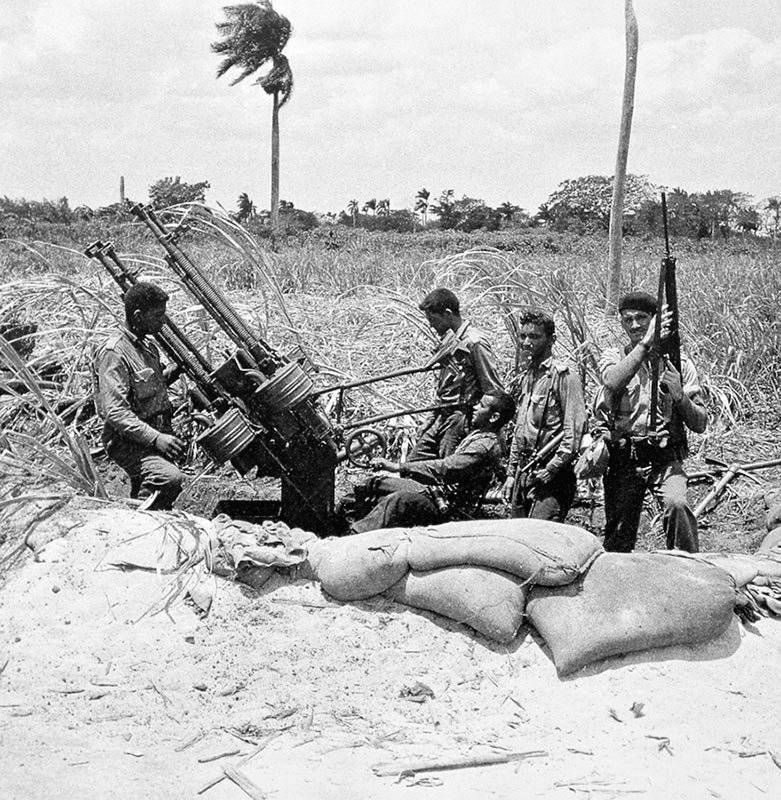
But no matter how hurried the Cubans were, the Soviet aviation technology was late at the start of serious hostilities. This became evident when opponents of the Castra regime began to conduct air raids to bomb cities and sugar cane plantations, Cuba’s only strategic raw materials, and to deliver weapons to groups of counterrevolutionaries. In these raids, several B-25s and converted civilian aircraft were used, based at different airfields in the US state of Florida, in particular Pampana Beach, 35 km from Miami.
Participated in one of the Piper Comanche 250 raids, 18 crashed in February 1960. Another aircraft of this type, trying to take out the leader of one of the gangs from Cuba, was shot down by an army patrol.
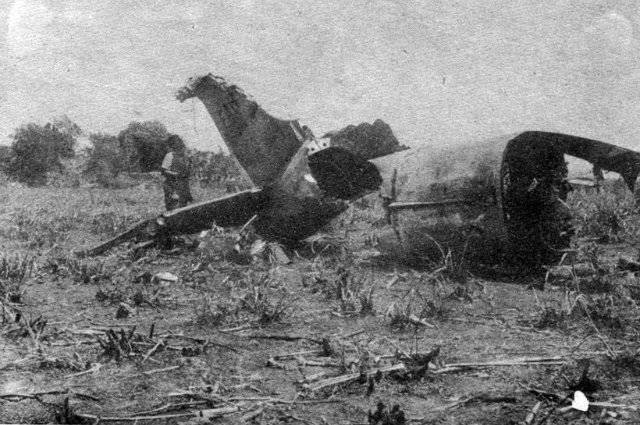
One C-46, which delivered weapons to counter-revolutionaries, was captured at the landing site by security officers, and C-54 (DC-4), damaged by anti-aircraft fire, made an emergency landing in the Bahamas.
FAR could not interfere with the attackers - there were no full-fledged fighters, radar installations, communications equipment. The motoresurs of the last remaining in the ranks of the aircraft were protected to repel large-scale aggression, the preparation of which was reported by intelligence. Rumors that small but experienced Air Force invasion forces were being prepared on the basis of the CIA Trak in Guatemala appeared at the end of 1960 in the press.
Their aircrew consisted of several dozen Cuban émigrés, former military and civilian pilots who had X-NUMX bombers B-16 and 26 C-10 bomber. But there were not enough people for the Air Force, and in January 46 was. The CIA stepped up the recruitment of pilots who had experience flying B-1961.
By April 1961 the "2506 Brigade" was finally formed, including four infantry, one motorized and one parachute battalions, tank the company and the battalion of heavy weapons - only about 1,5 thousand people. On April 13, 1961, the amphibious assault of the 2506 Brigade plunged into 7 large transport ships of the Liberty type and marched towards Cuba.
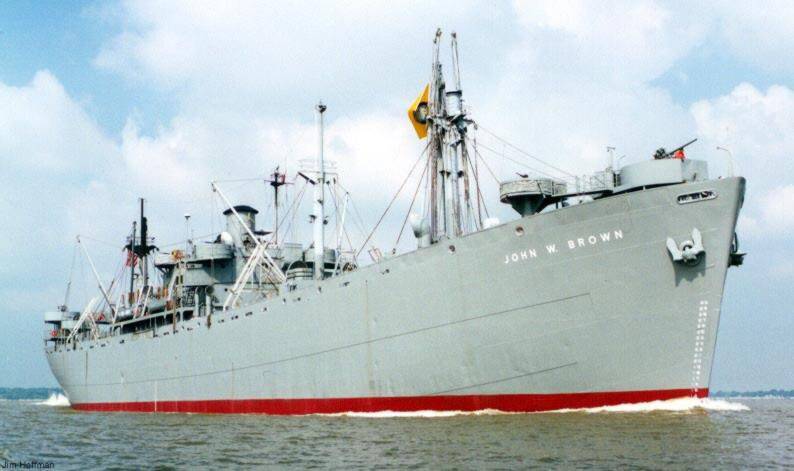
16 April, in 45 miles from the island, they were joined by two tank landing ships and landing barges carrying the brigade combat equipment. The purpose of the naval assault was to land on two (originally planned on three) bridgeheads in the Bay of Cochinos: two battalions on the coast of Playa Larga, and the rest of the forces at Playa Chiron (Bay of Pigs).
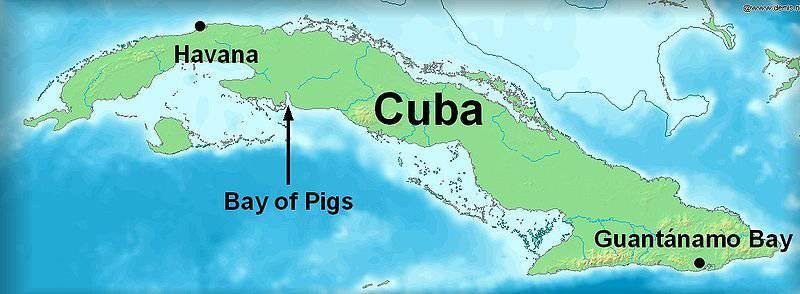
At the same time, the parachute landing should have landed near the village of San Bale. The aim of the operation was to capture a section of the coast and a small runway in Chiron to relocate its air force there and deliver reinforcements. The air forces of the 2506 Brigade entered the battle two days before the landing of the main landing force. After midnight 15 on April 1961 from Puerto Cubezas airfield in Nicaragua, X-NUMX B-9 bombers took to the air. Eight of them hit the FAR main bases, and the ninth headed for Miami, where his pilot tried to convince reporters that a rebellion had begun in Cuban aviation.
The crews of attack aircraft returned to the base without a loss, although somewhat battered by anti-aircraft fire, and reported a major success: at the San Antonio airbase, 8-10 aircraft were put out of action, and in Ciudad –Libertad (former Colombia) - 8, and Santiago de Cuba - 12, trucks with ammunition exploded, airfield buildings destroyed. But where could such loss figures come from, in the amount exceeding everything that FAR had at that time?
Probably, the point here is not the excessive boasting of the participants in the raid. Most likely, the blow fell on decommissioned aircraft standing at the airfields, which could not be distinguished from the serviceable from the air. In fact, as a result of the raid, 1-2 B-26, 2-3 Xi Fury and 1-2 transport and training aircraft failed, i.e. about half a dozen cars, some of which were later repaired.
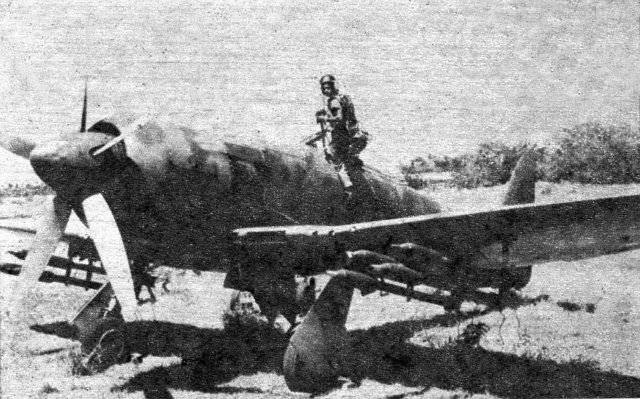
Repair work unfolded at a feverish pace immediately after the end of the raid. All airplanes capable of “flying and shooting” immediately relocated closer to the area of the intended landing of the invasion forces - to the airbase of San Antonio de Los Banos. Stop the counterrevolutionaries could only FAR aircraft. The motors of most of them gave half the power of a power, the lanterns did not close, and some of the chassis were not removed. The pilots themselves called them the “Homeland or Death” type aircraft - and they were really ready to conquer or die! Such a fate befell the pilot Acosta, who took off on the night of 14 on 15 April on his T-33A in a reconnaissance flight over the sea. During landing, the landing gear was not released, and then the plane caught fire and fell into the sea. The ten FAR pilots who were available were mostly young guys, among whom 39-year-old captain Enrique Carreras Rojas seemed like a "grandfather." Most of them did not have combat experience, although some began to fly in partisan air forces, and Lieutenant Alvaro Prends Quintana was a personnel pilot of the Batista Air Force, who had time to go through jet training in the US and was imprisoned in 1957 for refusing bomb the rebels. At dawn 17 April, FAR pilots were ordered to strike at the invading ships. Of the eight aircraft that were in San Antonio, three were prepared for the first flight - a pair of “Sea Fury” and one B-26. Around noon, the troika strike went into the air. Captain Rojas led the group on a fighter, he was accompanied by Lieutenant Gustavo Bouzak on the second fighter and Captain Luis Silva on a bomber. Actually, the first flight to B-26 was assigned to Captain Jaquez Lagas Morrero, but Silva voluntarily took a seat in the cockpit and went on a mission.

B-26 Invader / FAR 933. On this 8 aircraft during the battles on Playa Chiron flew DL Marrero. Downed B-26 with the board number FAR 903 looked the same. The Invaders "gusanos" also looked the same, but their tail numbers are unknown
Two other aircraft also attacked targets without a miss, almost all missiles hit enemy ships. The trio returned to the base, where by that time they managed to prepare two more aircraft. In the second flight, in addition to the former crews, Lieutenant Ulsa participated in the Sea Fury and the crew of Captain Lagas Morrero on B-26. This time, Captain Rojas ordered eight missiles to be hung under his "Sea Fury" wing - and they all hit the middle of the Rio - Eskandio ship loaded with fuel and ammunition. He also served as a staff ship and, after taking off, took with him the main means of communication for the 2506 Brigade. Other FAR pilots, breaking through anti-aircraft fire, delivered sensitive blows to the landing craft and boats.
Captain Morrero, in his B-26, attacked a tank landing ship: "I attacked one of the ships south of Playa Chiron. Tanks and other equipment were unloaded onto barges. I fired a missile that hit the fuel tank on the upper deck ... scattered shattered! "
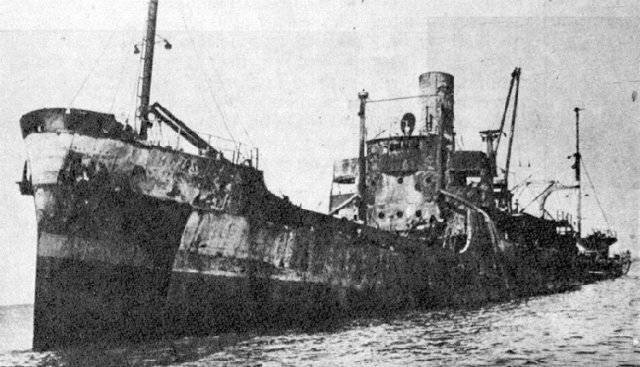
By this time fighting was under way. Fierce fights turned around and in the air. The pilots of anti-Kastrovskaya aviation, confident of the defeat of FAR, prepared only for relatively safe attacks on isolated units of government troops. But even with this task, they coped unsatisfactorily, often wasting ammunition on secondary targets and civilian objects. The meeting with the republican aviation in the air was not included in their calculations. At the first moment they took the FAR aircraft for their own. It cost them dearly. Having completed one of the attacks on the ships, Rojas discovered the B-26 bomber in the air next to him. "At first I thought that it was L. Silva's plane, but then I determined from the tail number that it was an enemy plane. I went to his tail and opened fire." Stitched in bursts of "Sea Fury", B-26 caught fire and fell into the sea near one of the ships. This was the first air victory of FAR. Following Rojas that day, Morrero, Silva and Hulse shot down one B-26, and in just April 17 the "gusanos" lost five planes.
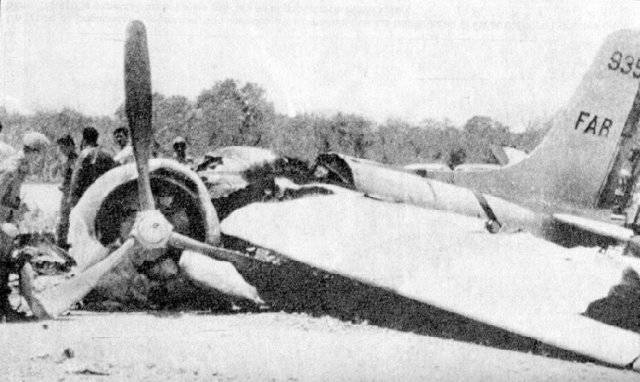
Sensitive losses suffered and FAR. Two B-26 squeezed K.Ulsa's fighter into the air and shot at gunpoint with machine guns, the pilot was killed. A "Invader" L. Silva with a crew of four people exploded in the air from a direct hit of an anti-aircraft projectile in the gas tank. There is evidence of serious damage to another "Sea Fury". The tiny revolutionary air forces lost a third of the planes and half the crew in a day.
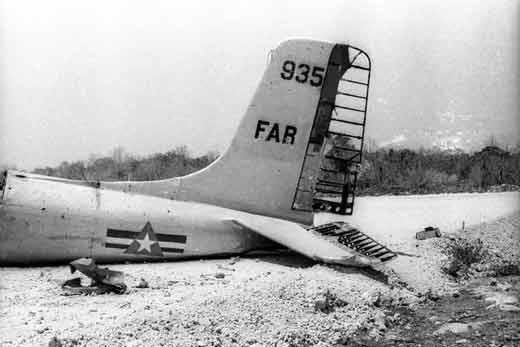
But the main goal was achieved. Half of the invasion vessels were sunk, with them a large amount of heavy weapons and ammunition went to the bottom. The command of the invading forces, stunned by unexpected losses, was forced to take the remaining ships 30-40 miles into the open sea, under the cover of the American fleet. Thus, the landed units not only lost a significant part of the reinforcements, but also remained without fire support from naval artillery (on transport ships there were 1-2 127 mm caliber guns and 5-10 anti-aircraft guns for this purpose). From the second day, the supply of the "2506 crew" had to be carried out only from the air - by parachute.
Nevertheless, the operational report of the Air Force invading forces in the morning of April 18 sounded cheerfully: "April 17 shot down B-26 FAR (" 903 ") and one" Sea Fury "was damaged so that it can not be used during the week. Pilot Falje reported to about the destruction of a truck with 20-30 people, 18 of which was killed. The infantry units destroyed one Sea Fury and knocked out the second. Now the enemy has probably two T-33A, two Sea Fury, 1 or 2 B -26. Our air forces today from 3 hours 30 minutes to 4 hours in the morning guard the disembarkation zone, and six aircraft they will try to destroy the remnants of Castre's air force. "
For its part, the FAR command set before the lieutenants of Quintan, Díaz and Mole the task of destroying the airplanes of the "2506 brigade" in the air, appearing above Cuban territory. Thus, 18 April was the decisive day in the struggle for air superiority.
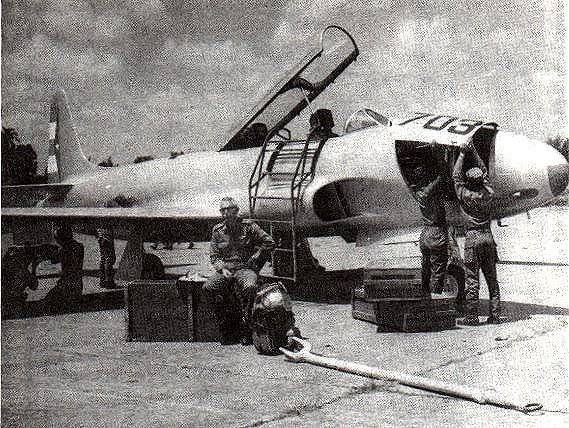
Quintana and Diaz, who only drove their T-ZZA jets from Havana in the evening of the last day and did not have time to take part in the hostilities, flew forward, Mole to “Sea Fury” was slightly behind due to slower speed. This is how Quintana himself described this flight: “We are going to form. To the right is the Del Pino machine, a Douglas plane at a distance. The height of 7 is thousands of feet and we are in a hurry to intercept the mercenary bombers.
- Airplane on the lower right! - Del Pino Diaz's voice is heard in the headphones. I see two B-26, which, dropping bombs, go towards the sea.
I order by radio to my slave to attack the slave of an enemy pair, and I myself attack the leader.
Then I made the first mistake - I forgot about the B-26 bow-gun battery and attacked the enemy in the forehead. With a dive, I went to the frontal on B-26, which was lower than me. The enemy turned the car and we rush in the forehead to each other.
We open fire almost at the same time, the B-26 pilot shoots inaccurately - the tracks fly over the lantern of my cabin. I missed too. I turn to the right, B-26 flashes to the left below me. I lay a steep combat turn and attack it in the afterburner. There is a battle all around, excited voices shout in the headphones. The B-26 begins to maneuver vigorously. I press the trigger, the tracks pass above the target. Again I attack - and again by. In desperation, I no longer notice that the oxygen mask slid aside, preparing for a new attack. B-26 goes over the sea towards Honduras, it is clear that I ran out of ammunition or fuel. Once again I catch up with the target at an angle of 80 degrees, catching in the frame of the sight. The track stitches B-26 from nose to tail, but it does not fall.
I abruptly turn away. Slipping so close to him that I see the rivets and faces of the pilots.
A new surprise: there are arrows on this В-26 - they shoot back! Fortunately, the tracks pass by. I perform a turn with climb for a new attack. B-26 leaves. Eh, I would have his eight machine guns! Alas, our T-33Аs are all-around training aircraft used as combat vehicles ...

T-33A Snooting Star / FAR / 01 - one of the two who fought on Playa Chiron. The second T-33A on Playa Chiron looked the same, but without a number and with yellow fuel tanks. He flew A. Huintana. In addition to him, Del Pinot Diaz, AFernandez and E. Guzrrero flew on both T-33А alternately.
On the radio I hear the voices of Del Pino and Douglas - they are in vain attacking the enemy. Their B-26 scoops, they failed to incite him. I chase my B-26. To knock him down, I am now ready for anything ... I catch the enemy in the sight, shoot the remaining ammunition from the minimum distance and turn it away, almost crashing into the tail of the B-26. From my hits, the left engine on the bomber flashes and the cockpit canopy flies to smithereens.
I do not have cartridges, the fuel is at zero; I don’t know if I’m going to San Antonio. B-26 is on fire, its left wing is on fire, a long train of smoke drags behind the plane. On the right side of the fuselage through the emergency hatch falls out the co-pilot of the B-26, parachute opens over it ...
B-26 finally crashes into the waves of Cochinos Bay. In the headphones I hear Del Pino's joyful voice: You knocked him down, knocked him down!
He and Douglas continue to pursue the second B-26. I'm leaving for the base. The fight exhausted all my strength. Fuel from my strength for a few minutes ... "
18 on April T-33 intercepted several more B-26 and C-46, and Sea Fury and B-26 of the revolutionary Air Force bombed the positions of the 2506 Brigade.
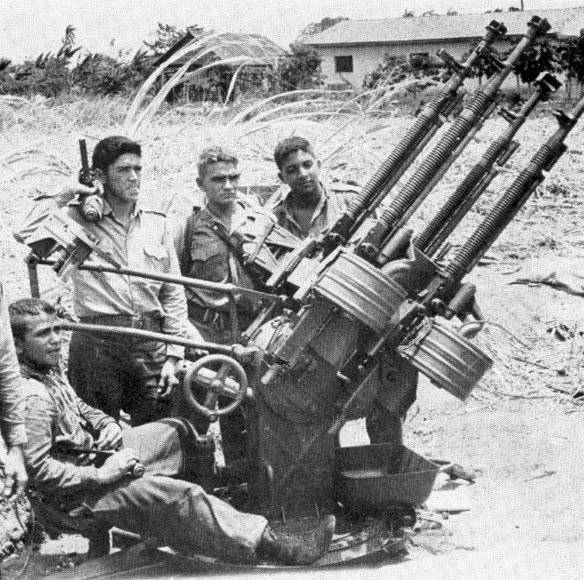
The anti-aircraft gunners also distinguished themselves: from the quadruple 12,7-mm DShK delivered during the night, they shot down two B-26 invasion forces, safely covering their ground forces. The preponderance of government troops by this time was so great that the "Gusanos" defended themselves without any enthusiasm. The air force of the mercenaries could no longer help their ground forces. By the evening of April 18, they lost two thirds of the aircraft and half of the personnel. Based on these disappointing results, the commander of the anti-Castro Air Force, Luis Cosme, said: “We have had enough losses. In my opinion, the operation failed and I see no point in continuing flights. No aircraft with Cubans on board will fly anymore!” There is information that on the evening of April 18 the positions of Cuban troops were attacked by airplanes of the United States Air Force and Navy, but this is unlikely - the decision to take part in the fighting of American aviation was made only on the night of 18 on April 19.
President John F. Kennedy allowed the fighter aircraft from the Essex aircraft carrier (but without identification marks) to cover the evacuation of the remnants of the “2506 Brigade” from the bridgehead in the morning of April 19.
Deck fighters F-8A "Kruseyder" from the US Navy carrier Essex were to provide air cover.
They were supposed to establish control over the airspace and destroy FAR aircraft, and a special group of B-26 bombers with American crews was intended to attack ground targets, since only one Cuban pilot agreed to take a risk.
At about three o'clock in the morning on April 19, four В-26 started at the “last parade” from the Puerto Cabezas airfield. Above the Bay of Cochinos they were supposed to appear in the morning 6.30, when escort fighters had already arrived the battle area. But when planning the operation, another overlap occurred: the big chiefs from the CIA and the Navy headquarters forgot about the difference in time zones. As a result, the last flight of the bombers took place two hours earlier than the fighters, and ended with a uniform defeat. They didn’t have time to render any assistance to the 2506 B-26 brigade - both T-33А of the revolutionary Air Force attacked them.
Two B-26 were shot down instantly, the third broke away from the pursuit and poured bombs on the premises of the Australia sugar factory, where the brigade headquarters was located, but was shot down by anti-aircraft gunners. The fourth bomber was damaged in aerial combat, dropped bombs into the bay, but still did not reach the base and fell into the sea. During the battle, one of the American pilots shouted on the radio: "MIGs are attacking us! MIGs are attacking!" In the future, this information gave rise to the legend of the participation of Soviet aircraft in repelling aggression. Fidel Castro commented on these rumors: “On the day of the bombing of our territory by B-26 planes based in Nicaragua, the counter-revolutionaries stated that our own planes bombed us, claiming that our air force was made up of planes that the Americans supplied to Batista. When we With the help of these old worn-out aircraft, they began to destroy their aircraft, they said that our air force was armed with MIGs. But we did not have MIGs ...
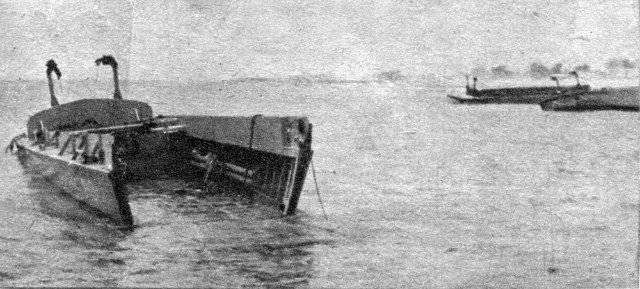
The adventure in Cochinos Bay ended for the United States and the Cuban counterrevolutionaries a great shame. The 2506 Brigade lost only 458 people (out of a thousand and a half who were to be disembarked!), Leaving half of their watercrafts and all their weapons on the coast. Air force invasion forces lost up to 12 aircraft B-26 and at least 4 transport C-46.
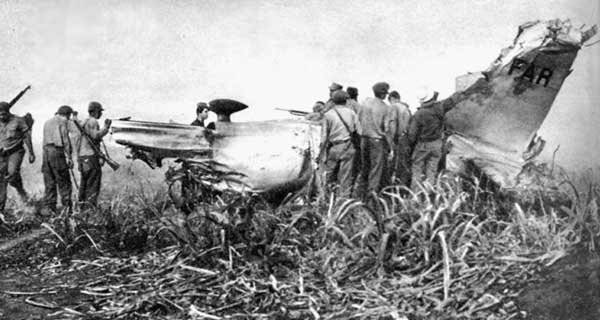
Losses FAR amounted to two aircraft. In addition, almost every Cuban pilot had sunk ships and amphibious boats on his account (large transports sank Morrero, Rojas, and Silva).
The command of the revolutionary armed forces made the appropriate conclusions from the experience of the battles on Playa Chiron, and the first of them was about the need to re-equip all arms and, first of all, aviation. Already in 1962, during the May Day parade, three squadrons of MiG-15 and MiG-19 passed over Havana.
And by the beginning of the "Caribbean crisis" in August 1962 in FAR there were several well-trained squadrons equipped with MiG-15, MiG-17F, MiG-19PF and MiG-19С. Fortunately, the “war of nerves” in the fall of 1962 did not escalate into a real war, and these planes took off only for training and patrol flights.
Based on materials:
http://prometej.info/new/history/980-plaia-xiron.html
http://www.xliby.ru/transport_i_aviacija/mir_aviacii_1994_01/p10.php
http://www.usinfo.ru/1961kuba.htm
http://conflictologist.narod.ru/bdc.html
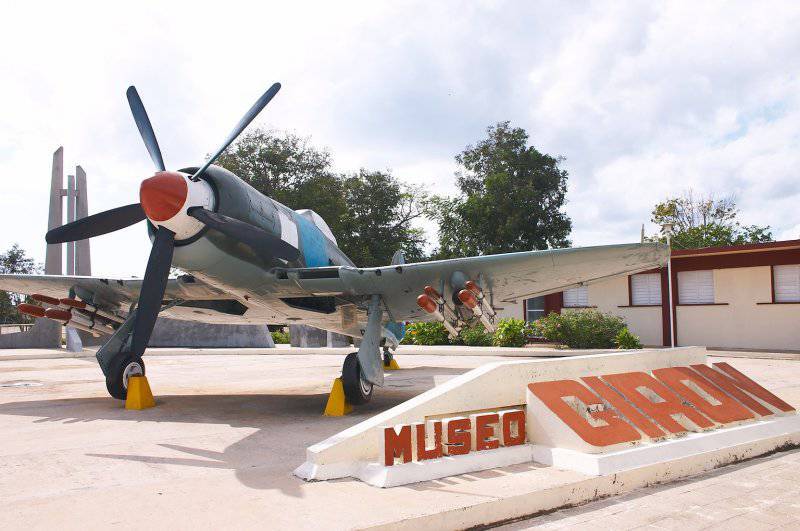
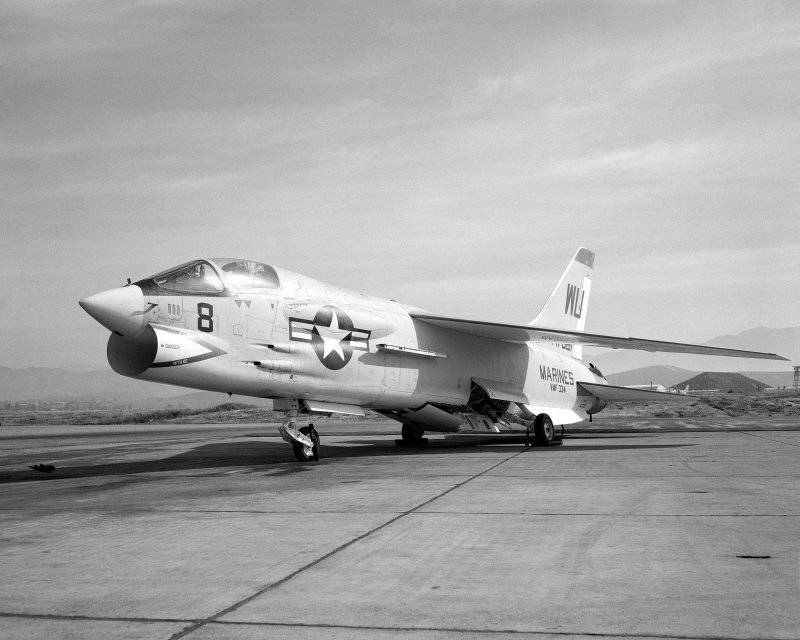
Information